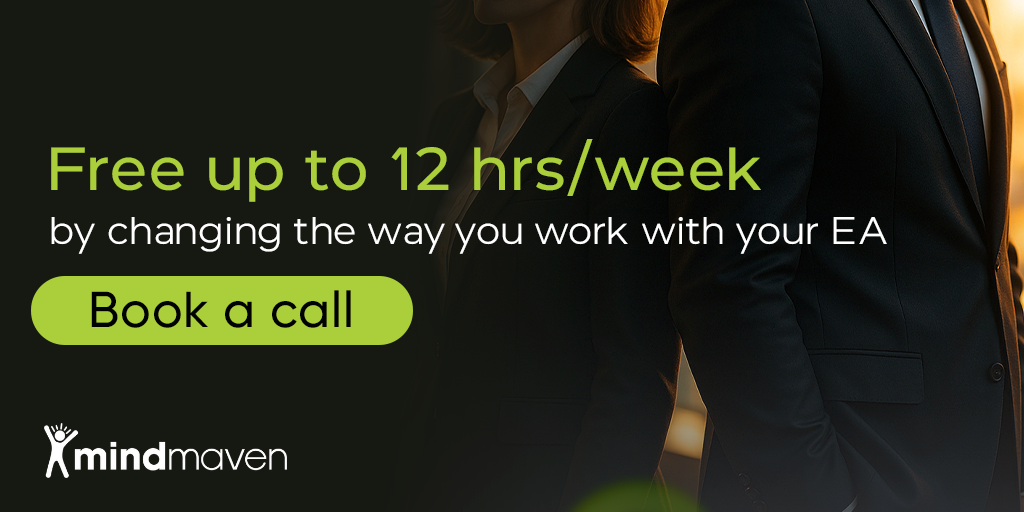Stepping into a new leadership role can feel like navigating uncharted waters. You’re inheriting a team full of expectations, adapting to a new culture, and trying to prove your value—all while figuring out what the business truly needs from you.
At Mindmaven, we help executives approach this transition with clarity, confidence, and intention. Through personalized coaching and proven workflows, we help create the leadership mindset shift needed to free up 12+ hours every week, build trust, and focus on your most strategic priorities.
In this episode of our Human First Leadership series, Mindmaven Founder and CEO Patrick Ewers sits down with Stephanie Hess, Chief Communication Officer at Discord, to explore strategies for a smooth and confident transition into a new leadership role.
Drawing on her extensive experience, including her tenure as Head of Global Communications and Marketing at Asana, Stephanie offers invaluable insights on embracing Human First Leadership to create a curious, compassionate, and effective team environment right from the start.
At the end of the article, you’ll also get free access to our How I Work Notion Template, designed to help you implement these strategies for enhanced productivity and seamless team collaboration, setting you up for success in your new leadership role.
Why Practice Human First Leadership?
Kicking off their discussion, Patrick delves into what Human First Leadership means to Stephanie, including how compassion, empathy, and transparency can transform team dynamics and drive impactful results.
Stephanie: “I love this topic. It’s been something that, over the last few years of my career, I’ve leaned on a lot more.
To me, Human First Leadership is really about the compassion and the empathy and the transparency you can bring to a team. And being vulnerable in a way that shouldn’t feel punitive, but should feel like you’re engaging and leading folks with your heart.
Really kind of opening the lines of communication early and often. I’m working at it every day – I feel like it’s a muscle that we all should be building.
It is something that you bring to the table to your work family, and then in your personal life as well.”
A self-proclaimed student of Human First Leadership, Stephanie explains why she continually strives to practice it in meaningful ways.
Stephanie: “Making sure that you can build a team that works together with empathy and understanding … means that the teams are going to gel faster, the collaboration is going to be better, and ultimately, the work that you do for the company is going to have a higher impact.”
Finding Fulfillment in Your Career
Patrick emphasizes the significance of Human First Leadership in creating a fulfilling work environment, stating: “It’s one of the best ways of running a business because you are going to have more people be engaged, more empowered, and probably better results.
It’s just not worth doing it any other way.
You have so much time that you spend on your career. It only becomes worthwhile if you feel like you are being treated as a human and are treating other people as a human.“
Stephanie adds: “If it just feels like we’re moving dials and in pursuit of profit, but not how we get the work done together, it feels very empty.
I’m not interested in doing empty work. I’m interested in doing work that matters with people that I care about.“
Overcoming Imposter Syndrome in a New Leadership Role
Starting a new leadership role often brings with it the challenge of imposter syndrome.
Stephanie shares her personal experience as she transitions into her new leadership role at Discord and how she leverages Human First Leadership to navigate this phase.
Stephanie: “I joined here about six weeks ago, and it’s like learning a new language.
It’s hard when you’re the person that’s coming in, even at the leadership level that I’m at, because this team has been together for a while, and they’ve been through a lot.
We’ve all been through a lot in the last few years as organizations and as companies, but my goal in coming is to be additive.
I’m using the human first muscle in a lot of ways for myself and giving myself grace on learning.
When you come in, and you don’t know everything because you’re not as fast as you were at the last place, that can be a breeding ground for imposter syndrome.
You’re like, ‘Oh, they hired me for a reason, but I’m not doing the thing yet.’
So I’m giving myself grace and, you know, giving myself some advice.”
How To Establish Yourself as a New Leader – The Land and Learn Method
Navigating new leader challenges requires strategic self-support and patience. Patrick asks Stephanie about her approach to establishing herself in her new position at Discord.
Patrick: “What exactly are you doing to support yourself?”
Stephanie: “Being mindful about my calendar, being mindful about the types of meetings that I’m doing and how much back-to-back meetings there are.
I have an amazing person that helps me with all this here at Discord, who’s just been brilliant and helping me architect what that day looks like.
Also, not feeling like when I get home, I need to make a plan for something, or I need to put some strategy documents together to prove myself.
But letting myself absorb, and sticking to the calendar of: I’m going to do these certain meetings, meet with these certain people, understand context for the business.
I think our intuition as marketers and communications peoples, we want to type something up right away, and I’m resisting the urge to do that, which is hard because we’re doers.
I’m an Enneagram Two. I want to be a helper.
In this moment, being a little selfish with the learnings of how the company works, what our consumers want, and what the cross-functional teams are is actually going to serve me well rather than typing up a slide deck.”
Patrick: “That’s really interesting. So basically, what you’re saying is, give yourself permission to land first and to learn first.”
Stephanie: “Land and learn!”
Patrick: “And then see learning as part of performing. If you do that, you end up ultimately getting faster to the point you want to get to.
There’s probably going to be higher performance because it’s just based on a more settled, more knowledgeable state than just this urge of wanting to prove to the world that you have a right to be here.”
2 Top Tips for Starting a New Leadership Role
Feeling the need to prove yourself immediately in a new leadership role can be overwhelming.
To help navigate this pressure, Patrick shares his top two pieces of tactical advice:
1. Never assume something is fact.
Patrick: “Give yourself permission to ask yourself every single time:
When I think that this is what the company needs, is this a fact, or is it an assumption?”
If you find that your conclusions are based on assumptions rather than facts, give yourself permission to learn more.
By seeking out factual information, it’s almost guaranteed that your initial assumptions will shift, leading to a more accurate understanding of the company’s needs.
2. Forbid yourself to make statements for the first two months.
Patrick: “Always state the things you want to do in the form of questions.”
For example, as a leader, you bring a wealth of experience, and it’s easy to make a classic assumption about what your new company needs.
Patrick: “You might actually be right, but the assumption is that they haven’t done that yet. Then you go ask, and all of a sudden, it’s like, ‘Yes, we tried this, and this failed miserably.'”
Stephanie adds: “I always say with teams that everyone arrives in their position as fully formed humans.
They had a life before they walked in the door and got the new badge of whatever company you’re working on. So respect that.
As a leader coming into this organization, these are fully formed humans with an organization that got this company to have 200 million people on the platform over a series of years.
They made great decisions around the things they needed to do at the time, we’re just in a different moment.
So how do I learn from those folks, their experiences, their context, and then how do we move it forward?“
Why Every New Leader Needs a Leadership User Manual
Creating a written leadership user manual is a transformative practice for anyone stepping into a new leadership role.
Stephanie shares her experience with this approach and how it helps to foster transparency and trust within her new team.
Stephanie: “One of the big things that I did before I started, and I shared it in my first week was I created a user manual for myself, and we did this at Asana.
This is just a simple document where you are a little bit vulnerable because you talk about the things that matter to you, the context for how you make decisions, things that earn your trust, and things that lose your trust.
Coming into the team and saying like, ‘Hey, here’s a little bit about me beyond the bio’:
- Here’s how I move through work.
- Here’s what I value: I value connection. I value empathy. I value transparency.
- I want input: Here’s what I do with feedback.’
It puts people at ease a little bit because I won’t be able to get to meet my whole team in one week.
When there’s a new leader everyone gets just a little bit nervous because they don’t know how those relationships are going to get built.
It just really helps me with this group, and Jason, our CEO, has one as well. So we shared the exchange of gifts in the beginning. Here’s a little bit about me; here’s a little bit about you.
We’re going to do that across the team here. So the team that’s been working together has that sensibility about each other.”
How to Successfully Implement a How I Work Document
Patrick highlights the power of creating a leadership user manual, known at Mindmaven as the How I Work document.
This exceptionally powerful document serves as a tool to clearly articulate your leadership style and preferences.
Patrick advises that, beyond simply producing the document, it’s crucial to follow a structured rollout approach:
Patrick: “First, you give it to people and let them consume it, but then there is a meeting in which you can discuss it.
In that meeting, you are basically saying, ‘I want you to ask three questions about what you’ve learned.’
Point out up to three things that you find aligns a lot with you and three things that are very different to you.”
This method serves as a shortcut to effectively understanding how to work with someone – a process that typically takes six to twelve months can now be condensed into a quarter.
Download Your Free How I Work Notion Template
Our How I Work Notion Template acts as a leadership user manual, helping you clearly articulate your values, decision-making styles, leadership communication strategies and preferences, and expectations.
This not only accelerates the team’s understanding of your leadership style but also sets the stage for improved productivity and smoother collaboration.
Whether you are entering a new leadership role or looking to enhance your existing leadership approach, access your free template now to streamline your team’s dynamics and create a more cohesive working environment.
Get the How I Work Notion Template.
Overcoming New Leader Challenges Starts Here
Starting a new leadership role is one of the most pivotal transitions in your career, and you don’t have to navigate it alone.
At Mindmaven, we specialize in helping executives implement human-first, high-impact leadership practices that free up 12+ hours every week while strengthening the relationships that drive success.
Through leadership onboarding best practices, leadership productivity tips, and effective team collaboration in leadership, our executive coaching engagements help you show up as the kind of leader your team deserves: present, strategic, and deeply connected.
Schedule a free 1:1 call with a Mindmaven coach to learn how we can help you lead with clarity, confidence, and systems that support your long-term success.



